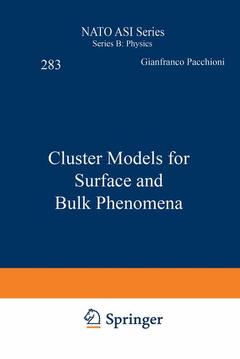Description
Cluster Models for Surface and Bulk Phenomena, Softcover reprint of the original 1st ed. 1992
NATO Science Series B: Series, Vol. 283
Coordinators: Pacchioni Gianfranco, Bagus Paul S., Parmigiani Fulvio
Language: English
Subject for Cluster Models for Surface and Bulk Phenomena:
Keywords
cluster; condensed matter; molecule; scattering; solid state physics
Publication date: 02-2012
712 p. · 17.8x25.4 cm · Paperback
712 p. · 17.8x25.4 cm · Paperback
Description
/li>Contents
/li>
It is widely recognized that an understanding of the physical and chemical properties of clusters will give a great deal of important information relevant to surface and bulk properties of condensed matter. This relevance of clusters for condensed matter is one of the major motivations for the study of atomic and molecular clusters. The changes of properties with cluster size, from small clusters containing only a few atoms to large clusters containing tens of thousands of atoms, provides a unique way to understand and to control the development of bulk properties as separated units are brought together to form an extended system. Another important use of clusters is as theoretical models of surfaces and bulk materials. The electronic wavefunctions for these cluster models have special advantages for understanding, in particular, the local properties of condensed matter. The cluster wavefunctions, obtained with molecular orbital theory, make it possible to relate chemical concepts developed to describe chemical bonds in molecules to the very closely related chemical bonding at the surface and in the bulk of condensed matter. The applications of clusters to phenomena in condensed matter is a cross-disciplinary activity which requires the interaction and collaboration of researchers in traditionally separate areas. For example, it is necessary to bring together workers whose background and expertise is molecular chemistry with those whose background is solid state physics. It is also necessary to bring together experimentalists and theoreticians.
Properties of Gas-Phase Clusters: Subshells, Shells and Supershells in Metal Clusters; T.P. Martin, et al. Thermionic Emission of Free Tantalum Clusters; T. Leisner, et al. Organometallic, Supported Clusters and Film Growth: Clustering of Metals on Semiconductor Surfaces; K.E. Miyano, et al. Photoemission Studies of Supported Metal Clusters, the Early Years; M.G. Mason. Condensed Matter: Surface Processes: Pauli Repulsion Effects in Scattering from and Catalysis by Surfaces; E.J. Baerends. Theory of Surface Clusters in External Fields; K. Hermann. Condensed Matter: Bulk Liquids and Solids: Cluster Approaches to Solid State Problems; W.C. Nieuwpoort, R. Broer. Cluster Models for Condensed-Phase Electron Transfer Processes; M.D. Newton. Development of SINDO1 for Extended Systems; A. Poredda, et al. Forty four additional articles. Index.
© 2024 LAVOISIER S.A.S.




